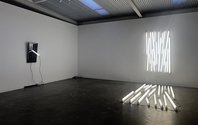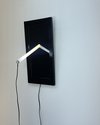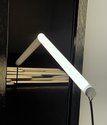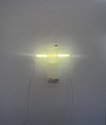John Hurrell – 24 July, 2024
The highly reflective framed works ('Post Black Windows', 1992) rely for their impact on spatial context and what else is glowing in the room. Most have a glossy black painted surface inside the frame, or else a transparent piece of glass. Such ‘captured' reflections will interact with the also reflected fluorescent tube poking out at the front—that extends at a downwards angle away from the wall.
Amongst the eight works by Culbert being presented in this show, half are collaborations with his great friend, Ralph Hotere.
Those highly reflective framed works (Post Black Windows, 1992) rely for their impact on spatial context and what else is glowing in the room. Most have a glossy black painted surface inside the frame, or else a transparent piece of glass. Such ‘captured’ reflections will interact with the also reflected fluorescent tube poking out at the front—that extends at a downwards angle away from the wall.
There is a different work (Post Black, Window #11 & #12, 1992) of two black unframed panels placed directly on the wall, positioned each side of an identically proportioned rectangle of transparent glass; with two vertical fluorescent tubes (flush with the wall) between the glass and panels. Because the glowing tubes are not projecting out at an angle, the light spreads out evenly along the wall behind the glass, and not on the black panels. It moves towards the centre of the clear glass, not outward away from the tubes.
This work has affinities with another much earlier work shown here, from 1978. Untitled features two white translucent plastic bidons (bulky bottles) arranged vertically on the wall, the bottom inverted one reflecting the other and the top one horizontally penetrated by a glowing fluorescent rube. The light seen through the plastic is granular, diffuse and slightly murky, while the light seen directly from the tube bouncing off the wall on either side is much more intense and startling.
With the later works, the reflective Culbert/Hotere collaborations here, there is a palpable conversation going on, or ‘team think’. It is as if a collective call-and-answer routine is going on within the shiny surfaces: with an emitting or radiating out, mixed with an absorbent, channelling, reflecting in.
Of the rest, two are b/w photographs taken by Culbert in Aotearoa and France. And there is Blind Window, 1991, with clusters of lined-up fluorescent tubes on the wall and in front on the floor. It alludes to a translucent blind pulled down over a window that has sunlight pouring in. That intercepted sunlight (besides delineating on the surface of the blind the rectangular shape of the window it hides), is also forming a shape on the floor. The two are connected.
Some of Culbert’s titles exploit a punning use of language with words like ‘blind’ and ‘post’ where you might have to pick a potential meaning. ‘Blind’ is the scrolled up screen positioned over windows, and not seeing, ‘Post’ means after and also the short glowing beam coming out of the black panel towards the floor.
There is nuanced ironic humour involved too. ‘Blind’ is used to reference works intimately preoccupied with sight, while ‘post’ penetrates a black void, flipping the notion, with light, of enabling sight by piercing—a perverse highly ambiguous twist.
This is a small show but one lovely in its intimacy, encouraging a viewer curiosity about light and its properties of radiation and reflection: how they affect surface, air and adjacent space. And the human imagination.
John Hurrell










 Advertising in this column
Advertising in this column Two Rooms presents a program of residencies and projects
Two Rooms presents a program of residencies and projects



This Discussion has 0 comments.
Comment
Participate
Register to Participate.
Sign in
Sign in to an existing account.